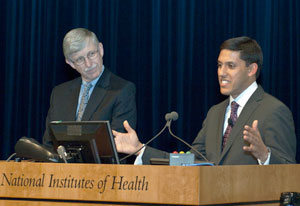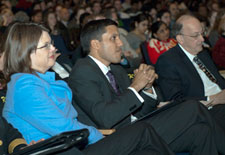USAID's Shah says science key to global health gains
January/February 2011 | Volume 10, Issue 1

Photo by Michael Spencer
NIH Director Dr. Francis S. Collins (left) and USAID
Administrator Dr. Rajiv Shah (right) said they are working
to better connect NIH research discoveries with global
health development.
By Steve Goldstein
Paying tribute to NIH as an institution that envisions the world as it could be, not as it is today, USAID Administrator Dr. Rajiv Shah extolled the role of scientific research in raising health standards around the world.
In a major health address at NIH, Shah called for a new global health system that better connects NIH research discoveries with development efforts on the ground "and produces real breakthroughs in our capacity to improve the health of the poor."
Harnessing the power of invention - scientific, technological and behavioral - on behalf of the developing countries is what will make a real impact on improving global health, Shah declared. "We cannot simply seek to do more of the same in an effort to provide services using currently available tools and technologies," he said. "Instead, we need to focus our efforts on facilitating a continuum of invention and innovation from bench to bush."
Shah repeatedly cited intramural and extramural research supported by NIH as crucial to enhancing human welfare across the globe.
The USAID chief delivered the David E. Barmes Global Health Lecture on Feb. 15 before a nearly full Masur Auditorium in the Clinical Center. In his introduction, NIH Director Dr. Francis S. Collins noted that this was believed to be the first-ever address to NIH staff at-large by a sitting USAID administrator and symbolized a closer relationship between the two agencies. The two directors share a connection with the University of Michigan, where Collins taught and where Shah received his undergraduate degree.

Photo by Michael Spencer
Newly-named Global Health Initiative
executive director Lois Quam met with
Shah and Fogarty Director Dr. Roger I.
Glass after Shah’s speech.
The Barmes Lecture is sponsored by Fogarty and NIDCR, where the late Dr. Barmes worked. Among those attending was former Minnesota health executive Lois Quam, the newly-named executive director of the Global Health Initiative.
Shah opened his remarks by praising NIH for representing one of America’s competitive advantages: advancing science, technology and innovation aimed directly at improving human welfare. "If we can harness that capability for the poorest communities in the world, we can leave an unparalleled legacy in global health in this next decade," he said.
The litany of health challenges is long and daunting, Shah explained. For example, a woman in southern Sudan is more likely to die in childbirth than finish high school.
Vaccines represent the "most transformative" breakthrough for saving lives, he said. The development of new vaccines is the best investment that can be made in efforts to combat malaria, tuberculosis and HIV/AIDS. A "cheap, effective" vaccine is the best hope for eradicating malaria, declared Shah. NIH research can help reduce the length of therapeutic regimes for TB as well. Developing a vaccine for HIV/AIDS is necessary for "closing the chapter" on its brutal history.
Shah cited the Center for the AIDS Programme of Research in South Africa at the University of KwaZulu-Natal in Durban, an NIH grantee, for its work on a gel microbicide for women to protect themselves from HIV infection. He said USAID was prepared to work with NIH to accelerate further testing and regulatory approval of this potential breakthrough. Circumcision campaigns have also been effective, he explained, adding that it was NIH that first discovered the "dramatic effect" circumcision could have in limiting the transmission of HIV. Reducing mother-child transmission of HIV is another approach that can be strengthened.
Equally important must be technologies to protect maternal and child health, from reducing maternal mortality to decreasing birth asphyxia. An NIH-funded study, First Breath, inspired USAID to join the fight against birth asphyxia, Shah noted.
Science and innovation form the tip of the spear in meeting the health challenges in the developing world. To this end, Shah said USAID will develop a "center of excellence" to accelerate product development and field introduction, bringing in industry experts and academic researchers to consult and investing "seed capital" in promising ideas.
USAID will launch a series of new scientific and technical challenge grant programs, designed to trigger innovations such as new diagnostics for community health workers and expanding the use of mobile phones to connect to health facilities.
The world as it could be, Shah asserted in closing, is one where the vaccinations afforded his recently-born third child were equally available to a child born in east Africa. "We look forward to being a partner with you, as the inventors and visionaries... that will allow us to succeed," he said.
More Information
To view Adobe PDF files,
download current, free accessible plug-ins from Adobe's website.